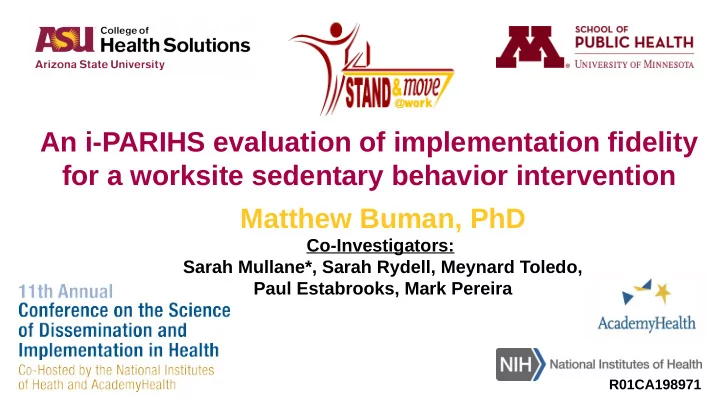

An i-PARIHS evaluation of implementation fidelity for a worksite sedentary behavior intervention Matthew Buman, PhD Co-Investigators: Sarah Mullane*, Sarah Rydell, Meynard Toledo, Paul Estabrooks, Mark Pereira R01CA198971
Physical actvity AND sedentary behavior are important for all- cause mortality Inactve ¼ U.S. pop Sedentary Actve Lifestyle Ekelund U et al. Sedentary Lifestyle Lancet 2016;388:1302– 1310. PMID: 27475271 Half U.S. pop A harmonised meta- analysis of data from Meetjng Below Exceeding PA guidelines PA guidelines PA guidelines more than 1 million men and women.
2018 HHS Physical Activity Guidelines for Americans https://health.gov/paguidelines/second-edition/
Recent 2018 US Physical Activity Guidelines Advisory Council Statement (Health Promotion) https://health.gov/paguidelines/second-edition/report/
Why the workplace for sedentary behavior? • Work has become more sedentary in recent decades due to technological advances • American workers spend 70-80% of their working day sitting • Sedentary behavior is ubiquitous, socially- reinforced, and habitual (and typically embedded in the workplace culture)
Stand & Move at Work Group Randomized Trial Design: 12-month intervention • N worksites: 24, 632 office-based workers • Healthcare/industry, government, and education sectors • Region: Arizona and Minnesota Length: 12 months + 24 month follow-up Outcomes: 0, 3, 12 (primary), and 24 month (follow-up) • activPAL 3c micro • Cardiometabolic, productivity NIH National Cancer Institute (R01CA198971)
Study design MOVE+ comparison STAND+ intervention Ergotron Workfit-T Behavioral target: Move more during Behavioral target: MOVE+ goal + the workday, with a goal of >30 increase standing time by 50%/day min/day.
Intervention components ADVOCATE REQUIRED
Reduction in workplace sedentary time • Sedentary time was reduced by 66 ± 14 min/workday (p<0.001) • No changes outside of work • No compensation activPAL micro
Reduction in musculoskeletal symptoms Nordic Questionnaire 12-month change in total symptom score STAND+: -1.7 ± 0.71, p<.05 MOVE+: 0.7 ± 0.75, p=0.40 Difference: -2.3 ± 1.06, p<.05
Clinically-meaningful reduction in cardiometabolic risk (dysglycemic group only) Absolute change in dysglycemic group (N=95) Full sample Glucose -7.73 (-19.2 to 3.75) (mg/dL) TG (mg/dL) -17.6 (-48.5 to 13.2) HDL (mg/dL) 0.16 (-2.88 to 3.21) SBP (mm Hg) -0.26 (-0.69 to 0.18) Dysglycemic HbA1c (%) -0.26 (-0.69 to 0.18) sample Weight (kg) -3.50 (-6.61 to -0.38) Body fat (%) -1.67 (-3.21 to -0.13)
Purpose This study aimed to conduct a retrospective evaluation of implementation outcomes from the Stand & Move at Work trial using the Integrated – Promoting Action on Research Implementation in Health Services (iPARIHS) framework.
iPARIHS framework (Integrated – Promoting Action on Research Implementation in Health Services)
Data Sources Efficacy trial: behavioral outcomes, readiness interviews, reach, fidelity Discovery interviews (SPRINT) of worksite wellness practitioners and thought leaders (N=42) Pilot implementation strategies in two additional worksites
Results: Large variability in efficacy among STAND+ worksites Sedentary behavior (min/8h workday) Top 25% Bottom 25% Change in sitting -86.6[7.6] -26.9[2.4] Change in standing 82.5[8.0] 23.4[5.8] Change in LPA 2.7[5.0] 2.7[3.9]
Results: Fidelity
Results: Innovation
Results: Recipient ADVOCATE REQUIRED
Results: Context
Summary of findings
Conclusions Even among efficacious interventions, large variability in efficacy can exist which may be explained by varying levels of implementation fidelity. Expert facilitation may be a key driver for improving both adherence and competence components of intervention fidelity. Future workplace interventions should consider level of training of worksite staff to deliver interventions, and when necessary include expert-based facilitation from trained staff. Future work should experimentally test delivery strategies comparing expert- vs. novice-based facilitation to understand differences in intervention effectiveness.
Sarah Mullane, PhD Funded by NIH R01CA198971 Coordinators: PIs: Matthew Buman, Arizona State University Sarah Mullane, Arizona State University Sarah Rydell, University of Minnesota Mark Pereira, University of Minnesota THANKS to the entire Stand & Move Team
Thank you! Matthew Buman, PhD mbuman@asu.edu
Recommend
More recommend